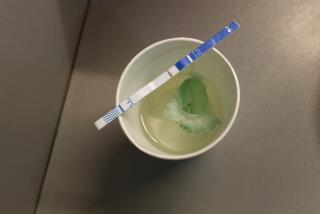To reduce the risk of opioid addiction, study suggests higher doses but fewer refills
Health experts have an intriguing suggestion for reducing opioid overdoses and deaths — asking doctors to prescribe bigger doses of the powerful painkillers.
It may sound counterintuitive, but providing more pain relief to patients right away might allow them to stop taking the pills sooner. And reducing the total amount of time that patients are on opioids could ultimately reduce the risk of addiction and abuse, new research suggests.
A study published Wednesday in the BMJ finds that for every additional week a patient takes drugs like oxycodone and hydrocodone, the chance that he or she will wind up abusing the drug increases by 20%. And every time a prescription for opioid painkillers is refilled, the risk of abuse rises by 44%.
Those calculations were based on data from more than 1 million Americans who had health and pharmacy insurance through Aetna. All of them had some kind of surgery between 2008 and early 2016, and 56% of them filled a prescription for an opioid pain reliever after their procedure.
Insurance records showed that 5,906 patients (or 0.6% of the entire sample) wound up “misusing” opioids. That means they became dependent on the drugs, abused them, or had an overdose.
Rates of misuse increased over the course of the study. In 2009, the research team tallied 183 cases for every 100,000 person-years; by 2016, that had risen to 269 cases per 100,000 person-years.
This trend occurred in spite of the fact that the rate at which opioids were prescribed peaked early in the study period, remained relatively flat for several years, and then fell. The researchers also noted that as the years passed, doctors tended to prescribe lower doses of painkillers and spread them out over longer periods of time.
When the team analyzed all the data to see which factors were most closely aligned with risk of misuse, the one that stood out was the number of prescriptions filled after patients left the hospital or clinic.
“Overall rates of misuse were low, but rates grew rapidly with increasing opioid use,” the study authors wrote. “The rate of misuse more than doubled among those with one refill … versus those with no refills.”
After adjusting for things like the age and sex of patients, what kind of surgery they had, their daily dose of opioids and other factors, the researchers determined that each additional week of painkiller use increased the risk of misuse by 20%, and each additional refill increased the risk by 44%.
The dosage of painkiller prescriptions was only weakly related to the risk of misuse. For instance, among patients who took the drugs for less than two weeks, the rate of misuse was about the same for those who got the equivalent of 40 to 50 milligrams of morphine each day as for those who got three times as much.
“These findings suggest a more nuanced understanding of the relation between duration and dosage,” the authors wrote. “Patients who require subsequent refills of opioid drugs are statistically more likely to have an episode of misuse, even years after the index surgery.”
And that’s why they say higher initial doses of opioids might be better in the long run — to make sure the pain is taken care of right away.
“Under-treatment of acute pain increases the risk of pseudoaddiction, chronic pain, and, potentially, overdose,” they wrote.
Follow me on Twitter @LATkarenkaplan and “like” Los Angeles Times Science & Health on Facebook.
MORE IN SCIENCE
When it comes to treating obesity, is fitness more important than fatness?
Even without nudging blood pressure up, high-salt diet hobbles the brain
Nature boosts your mental health, and you don’t even have to leave the city to reap the benefits







